Mad Hedge Biotech and Healthcare Letter
June 27, 2024
Fiat Lux
Featured Trade:
(THE BIOTECH LEATHERNECK THAT WON’T STAND DOWN)
(VRTX), (CRSP), (ABBV)

Mad Hedge Biotech and Healthcare Letter
June 27, 2024
Fiat Lux
Featured Trade:
(THE BIOTECH LEATHERNECK THAT WON’T STAND DOWN)
(VRTX), (CRSP), (ABBV)

Back in my Marine days, I remember being dropped in the middle of nowhere during a grueling field exercise. No map, no compass, just our wits and training to guide us back to base.
The odds were stacked against us, but we adapted, improvised, and overcame. Fast forward to roughly half a century, and I'm seeing the same spirit in an unlikely place - the biotechnology sector.
Vertex Pharmaceuticals (VRTX) has been executing maneuvers that would make any seasoned Marine proud. They move with the precision of a well-oiled M16 and the adaptability of a Force Recon team.
Their strategic acquisitions? As coordinated as an amphibious landing. That pipeline of theirs? Locked and loaded like a Marine fire team.
As I dive into Vertex's recent maneuvers, I can't help but see parallels to the strategies we used to employ. They're not just developing drugs – they're waging a full-scale assault on diseases that have long evaded defeat.
It's this Marine-like tenacity that's kept this $122 billion biotech on my radar, and why I think they've still got plenty of fight left in them.
Remember when I last wrote about Vertex in February? The stock was already hotter than a mess tent coffee pot then. Since that newsletter, it's climbed another 10%, leaving the S&P 500 in its dust like a young boot on a forced march.
And if you've been holding onto Vertex for the past decade? Well, pour yourself a whiskey and celebrate. You're sitting on a 545% return. That's not a typo, my friends. It has truly beaten the S&P 500 by over 300 points.
Now, I know what you're thinking. "John," you say, "hasn't this non-dividend payer run out of ammo after adding $20 billion to its market cap?" Well, let me tell you why I think Vertex still has enough firepower to make even a seasoned Gunny sit up and take notice.
So, here's the skinny on Vertex – they've got a knack for developing groundbreaking drugs that would make even our old field medics green with envy. They lock 'em down with patents tighter than a drill sergeant's schedule, and dominate niche markets like we used to dominate obstacle courses.
In Q1 2024, Vertex hauled in $2.69 billion in revenue, up 14% from last year. That's not just chump change – that's serious cabbage, even by Wall Street standards.
But here's where it gets interesting, and I mean more interesting than finding an unopened can of beer in your rucksack after a long hump.
Vertex isn't just sitting pretty. Their late-stage pipeline is packed tighter than a C-130 on deployment day, full of potential blockbusters that could change lives – and fatten our wallets.
Take Vanzacaftor, for instance. This cystic fibrosis drug is showing more promise than a boot camp graduate on family day. If it lives up to the hype, we could be looking at a new gold standard in CF treatment.
And then there's Suzetrigine. Now, this one's got me more excited than a three-day pass in Vegas. It's a non-opioid painkiller, and with the opioid crisis still raging harder than a Category 5 hurricane, a safe, effective alternative could be a game-changer.
Early data looks promising, and Vertex is pushing to finish its rolling submission by Q2 2024. As for its potential market? Well, that's bigger than the chow line on Thanksgiving.
We're talking about 80 million patients prescribed pain meds in the U.S. every year, covering one billion calendar days of treatment.
If Suzetrigine can grab even a slice of that pie, we're looking at another potential blockbuster that could make AbbVie’s (ABBV) top-selling Humira look like small potatoes.
But Vertex isn't content with just dominating CF and pain management. They're also pushing into new territories.
In April, they dropped $4.9 billion to snap up Alpine Immune Sciences, grabbing the rights to Povetacicept. This mid-stage drug targets IgA Nephropathy, which affects about 130,000 people in the U.S. That's a smart flanking maneuver if I ever saw one.
On top of all these, though, I think the biotech’s real showstopper might be Casgevy, Vertex's gene therapy for sickle cell disease and beta-thalassemia.
Developed with CRISPR Therapeutics (CRSP), this cutting-edge treatment uses CRISPR gene-editing technology.
It's like having a sniper rifle when everyone else is still using muskets. Vertex sees this as a potential multi-billion dollar opportunity, and I'm inclined to agree. It could be bigger than the Pentagon's budget – well, almost.
Look, I get it. Vertex doesn't pay a dividend, which might turn off some of you income-focused folks faster than a week-old MRE. But for those willing to bet on growth, this biotech juggernaut still has plenty of fight left in it.
With a killer pipeline spanning CF, pain management, kidney health, and even type 1 diabetes, Vertex is primed to keep growing like kudzu in August.
Their solid portfolio and promising drug candidates make it a compelling investment, and those revenue and EPS projections? They're music to my ears – sweeter than Taps at the end of a long day.
Here's my take: With a fair stock price target of $566, Vertex still has significant upside potential. I think it’s a biotech powerhouse that deserves a spot on your watchlist – right next to your old service medals.
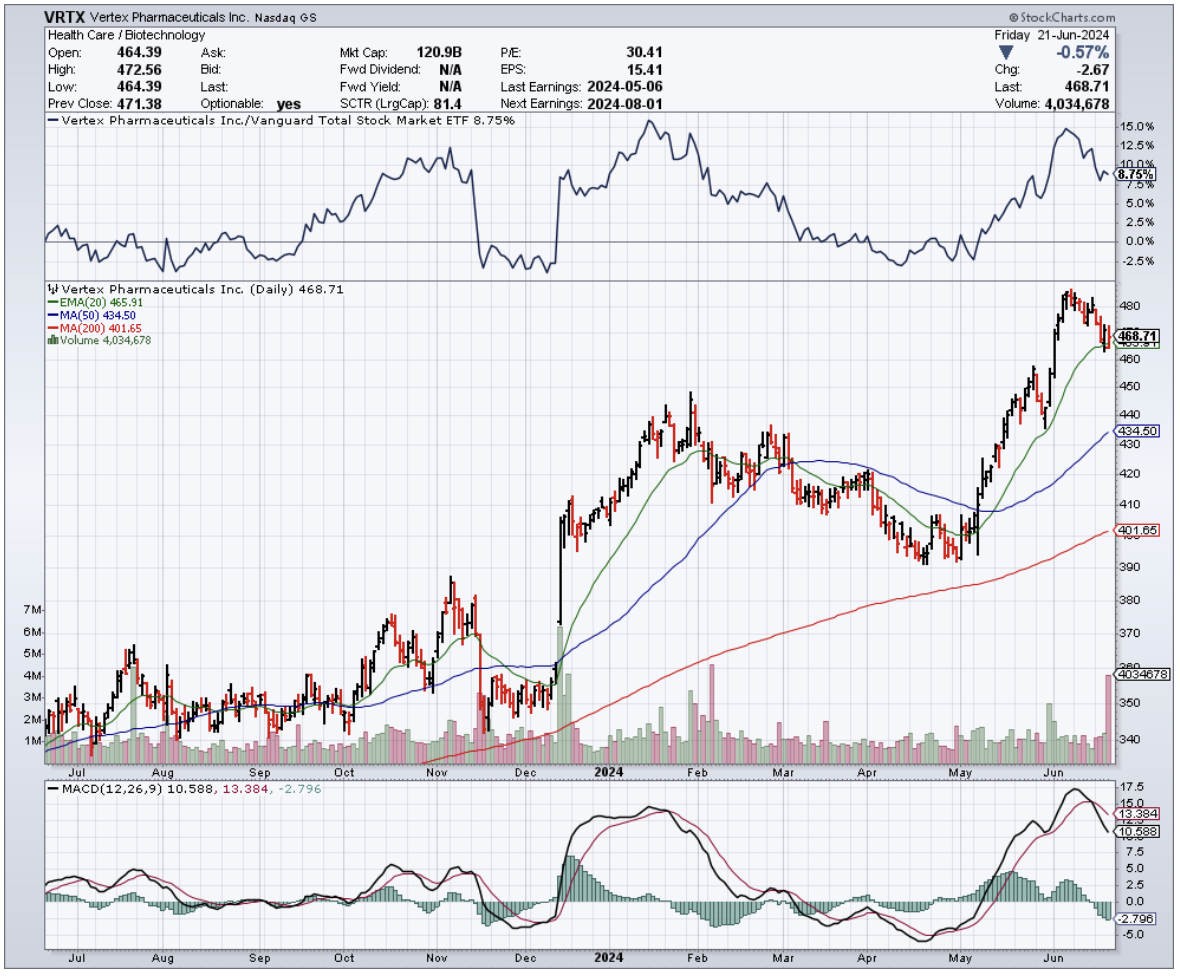
Mad Hedge Biotech and Healthcare Letter
June 25, 2024
Fiat Lux
Featured Trade:
(MORE THAN MEETS THE (WALL STREET) EYE)
(MRK), (PFE)

Dawn breaks, and as usual, I'm buried nose-deep in my morning ritual. You will find me, fervently hopping from one news site to another, much like a kangaroo in the wild.
This means my mornings are a mixed bag of global news digest — from German dailies to French periodicals (thank goodness for translation tools, right?), all part of an old habit from my days as a reporter.
So, why am I blabbing about this?
Well, it's because of a recent headline that grabbed my attention: "This drug can "melt away" bowel cancer," screamed BILD, Germany's numero uno newspaper.
Now THAT made me sit up straight. And the medicine they were gushing about? Keytruda from our very own healthcare titan, Merck & Co. (MRK).
Don't get me wrong. Merck’s been on my radar long before this, but I didn’t really give it much thought until the last quarter of 2023. Why? Well, with an annual return shy of 7% since January 2004, it wasn’t exactly screaming “look at me.”
But as life would have it, the story changed around 4Q23. All of a sudden, I found myself in the Merck rabbit hole, and boy, the wonders I found there.
Merck has been making waves in major programs like oncology, helping not just my portfolio, but countless patients with serious health conditions.
Just this month, at the American Society of Clinical Oncology (ASCO) meet—think of it as the Oscars for oncology nerds—Merck really strutted its stuff. Since 2021, their oncology portfolio has ballooned from 40 to 53 approved indications, and approvals in early-stage cancers have jumped from 2 to 10. Impressive, right?
And here’s the most impressive update of all: Keytruda alone has snagged 9 new early-stage US approvals.
Then, there’s also the PD-1/PD-L1 heavyweight, which is the lone therapy proving an overall survival benefit across lung, renal, breast, and cervical cancers.
To fortify its case, Merck has over 30 Phase III trials with 30,000 patients targeting earlier treatment. Crucial studies demonstrating survival rates for early intervention - a win for patients and healthcare systems alike.
Now, I've skipped some nitty-gritty details about these drugs, mainly to avoid turning this into a science class. The focus here is the bigger picture: how well Merck is positioned for growth.
Merck's already helping 2.6 million people worldwide. But what's driving this? Their 53 approved indications across 23 tumor types and two tumor-agnostic indications. Not just in the U.S., but also in the EU and Japan. And guess what? They're just getting started.
The company’s oncology pipeline is predicted to generate a whopping $20 billion in sales by mid-2030. Current products not included.
On top of that, they are aiming for $63.1 billion in total revenue this year alone.
Oh, and if you thought Merck was just about cancer, think again. They’ve just thrown a gauntlet at Pfizer (PFE) with their new FDA-approved pneumococcal vaccine, Capvaxive.
For context, Pfizer has been leading the pneumococcal vaccines market like a seasoned quarterback with its Prevnar shots, raking in a cool $6.4 billion just last year.
Just last week, though, Merck got the green light from the FDA for Capvaxive, designed specifically with adults aged 18 and up in mind. It zeroes in on those nasty strains most responsible for causing pneumococcal disease in adults aged 50 and older. Between you and me, that makes it one-up on Pfizer’s Prevnar 20.
Now, I hear you asking, "John, is FDA approval the finish line?" Not by a long shot. This is just the intermission. Next up, we've got the CDC’s advisory committee recommendations, which could turn this game on its head.
At this point, most adults look to Pfizer for their shots. But, if the CDC switches their recommendation in favor of Capvaxive, they'll be the ones leading the charge in the pneumococcal vaccine market.
So, what does that mean for stockholders?
Excluding Capvaxive’s potential earnings, Merck has actually been on a roll, making more dough in the first quarter of this year than a baker's first shift.
In the first quarter alone, their vaccine portfolio, headed by GARDASIL, saw a 17% increase in sales. Even currency headwinds didn't stop Merck from outdoing itself.
After 13 consecutive annual hikes, Merck dishes out dividends like candy at a parade. You're looking at a yield of 2.4% - a sweet deal if I ever saw one.
And I have to say, Merck's been putting on quite a show, outperforming the Healthcare ETF over the last decade with 225% returns.
But here's the best part - the show isn't over. With expected EPS growth of 14% and 8% in 2025 and 2026 respectively, this stock is undoubtedly on a tear. With an A+ credit rating and a below 1x leverage ratio in 2024, Merck is proving to be a standout in the healthcare arena.
Now, I’m not one to tell you where to put your money, but if Merck keeps up this pace, their path of robust EPS growth and a powerhouse portfolio could make them a standout in your portfolio too.
So, maybe give that old stock a new look. Who knows? It could be just what the doctor ordered.
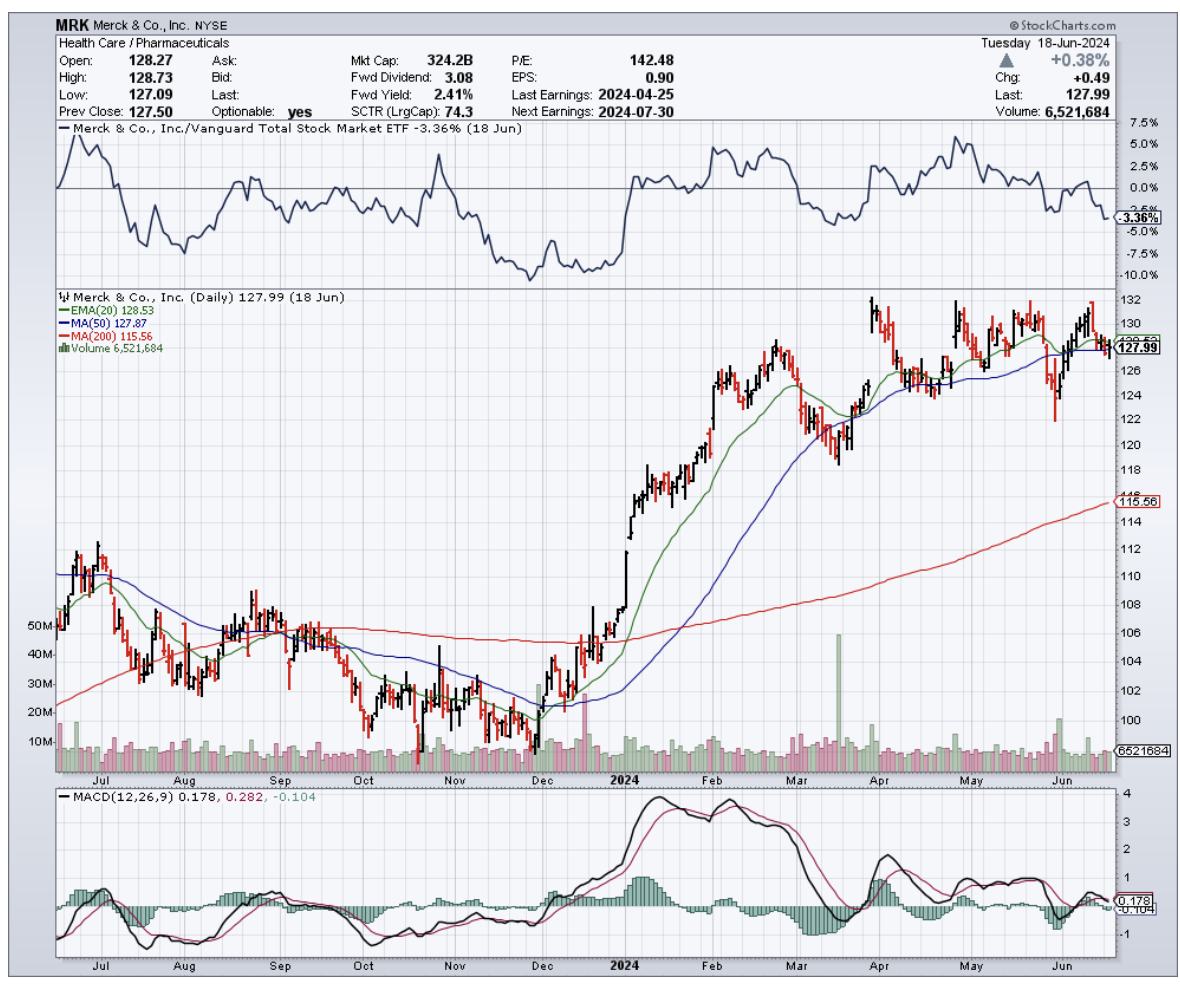
Mad Hedge Biotech and Healthcare Letter
June 20, 2024
Fiat Lux
Featured Trade:
(VAX TO THE FUTURE)
(AMGN), (RHHBY), (BNTX), (MRNA), (GNCA), (IOVA)

Let's have a heart-to-heart, you and me – about cancer, jabbers, and snake oil. If you think vaccines have been around for a while, you're on the money, my friend.
Over centuries, they've done a bang-up job wrestling down deadly infectious diseases and picking our collective life expectancy off the floor.
But what if I told you there's a different kind of magic we're still waiting for in the world of vaccines?
God's truth, I kid you not, science has been hammering away at this for years: creating vaccines to kick cancer square in the posterior. Yet, like an ardent investor waiting for the grand payoff, we've seen more flops than a fish outta water.
You can count on your one hand the number of cancer vaccines approved by the FDA since that first green-lit in 1990.
Let's not stammer about the bush, it's three – Provenge by Dendreon Pharmaceuticals, Imlygic by Amgen (AMGN), and Tecentriq by Roche (RHHBY).
Meanwhile, our old reliables – chemo, radiation, and the surgeon's knife – have, like battle-weary soldiers, been holding the fort for decades. But even they face formidable foes: nasty side effects, a bill that'll make a Rockefeller blanch and a diminishing punch against advanced cancer.
And the stats tell a story, but it ain't a happy one. Barely 59% of cancer patients treated with standard chemo make it through the five-year mark.
Until now.
Looking back, it's clear we've been a few beans short of a chili in our understanding of how the immune system and tumors get along — or rather, don't.
Now we know these devious cancers have been hoodwinking us with a starter kit of escape tools, literally tricking the immune system into playing “hide and seek.”
That’s where the likes of BioNTech (BNTX), Moderna (MRNA), Genocea (GNCA), and Iovance (IOVA) come in. To date, there are over 350 clinical trials focused on this field.
And if these new kids on the block deliver, we'll be singing hallelujahs with 83% five-year survival odds instead of the grim 59% chemo gives us.
As for those already in late-stage battles, where chemo only offers a bleak 4% five-year survival, immunotherapy could boost that to 23%.
So, what's the game-changer? Immune-modulating cancer vaccines.
Unlike traditional treatments that attack cancer cells directly, these vaccines train your immune system to recognize and destroy cancer cells like a well-trained bouncer booting out unruly party crashers.
Contrasted to the old brute force methods like chemo, and trust me, I’ve had some friends go through that ordeal, these vaccines are more like a sniper - taking precise aim only at cancer cells.
Plus, side effects? Minimal, my friends. But the cherry on top? These vaccines could potentially be your long-term bodyguards against cancer.
Now, I'm sure you love crunching numbers as much as I do, so here's some food for thought - the global cancer vaccine market was worth a cool $4.06 billion in 2019 and is projected to triple to $12.85 billion by 2027.
I mean, come on, that's a compound annual growth rate of 17.4%. It’s like watching your favorite sports team go on a championship run, season after season.
And the broader cancer immunotherapy market, sitting pretty at $75 billion in 2022, is on track to hit $120 billion by 2030, boasting a 14% CAGR.
These are not just empty promises either. We're seeing real progress - BioNTech and Moderna are developing personalized cancer vaccines that target unique tumor antigens.
Then there’s Genocea and Iovance, busy rolling out “off-the-shelf” cancer vaccines like fresh donuts off a conveyor belt.
This is a critical development, as around 70% of cancer patients develop resistance to chemotherapy.
These new immunotherapy contenders, with an overall survival rate of 50% compared to just 22% for those resistant to chemo, with every single patient potentially scoring against the dreaded C, and not fretting about chemoresistance. Talk about a fighting chance.
Overall, I think the cancer vaccine field is the Wild West of biotech – exciting, unpredictable, and potentially very rewarding. With companies pouring money into R&D, fueled by rising cancer rates and expedited FDA approvals, the race is on.
Immune-modulating cancer vaccines might just be the sheriff that this Wild West of cancer treatment needs, flipping the script on what used to be a death sentence into something we can manage.
Now, I'm not saying you should throw all your eggs in one basket, but keep a close eye on those mavericks like BioNTech, Moderna, Genocea, and Iovance. They could be the dark horses in this race.
Add them to your watchlist, and when the market hiccups and those share prices dip, that could be your chance to get a piece of the action.
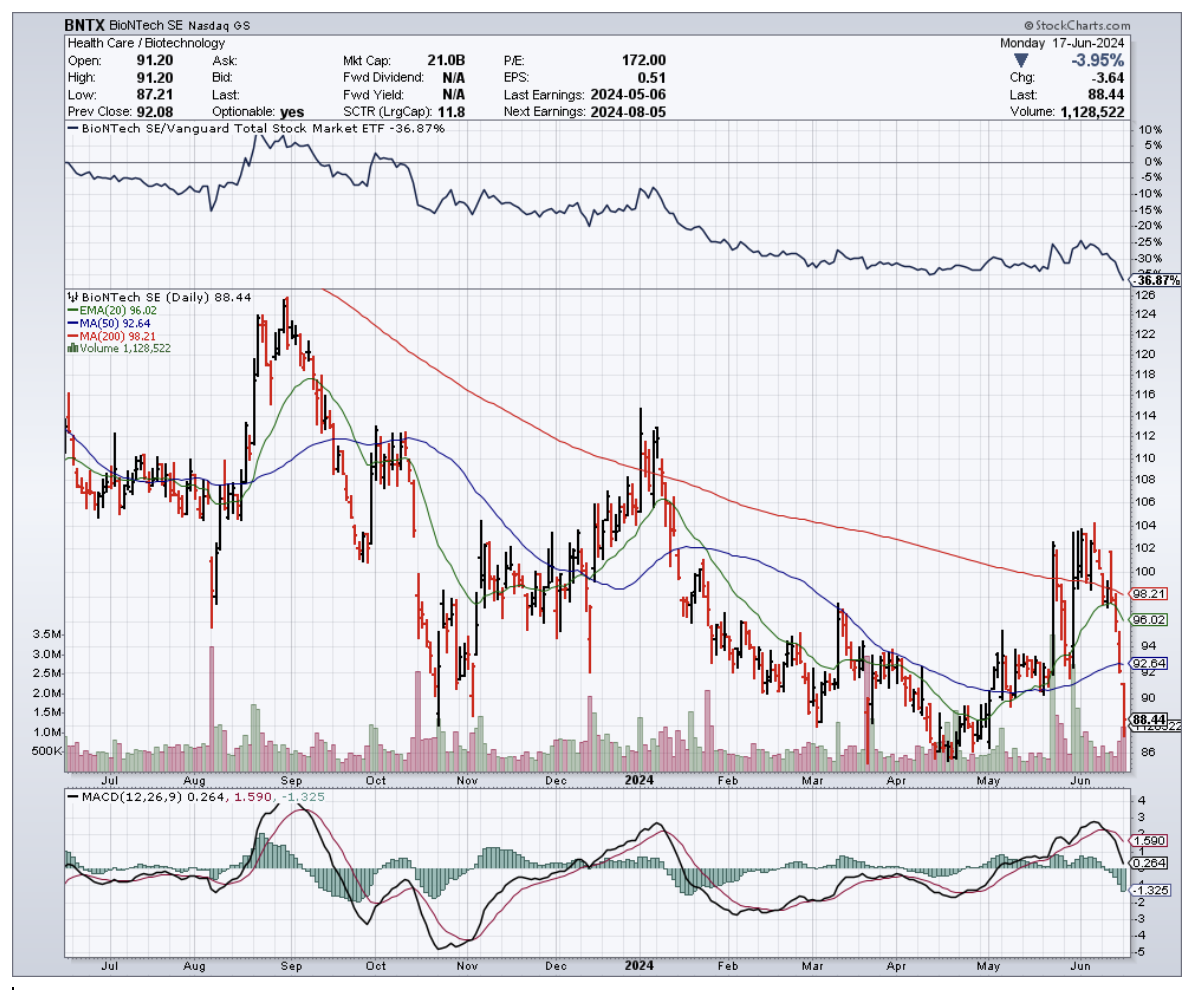

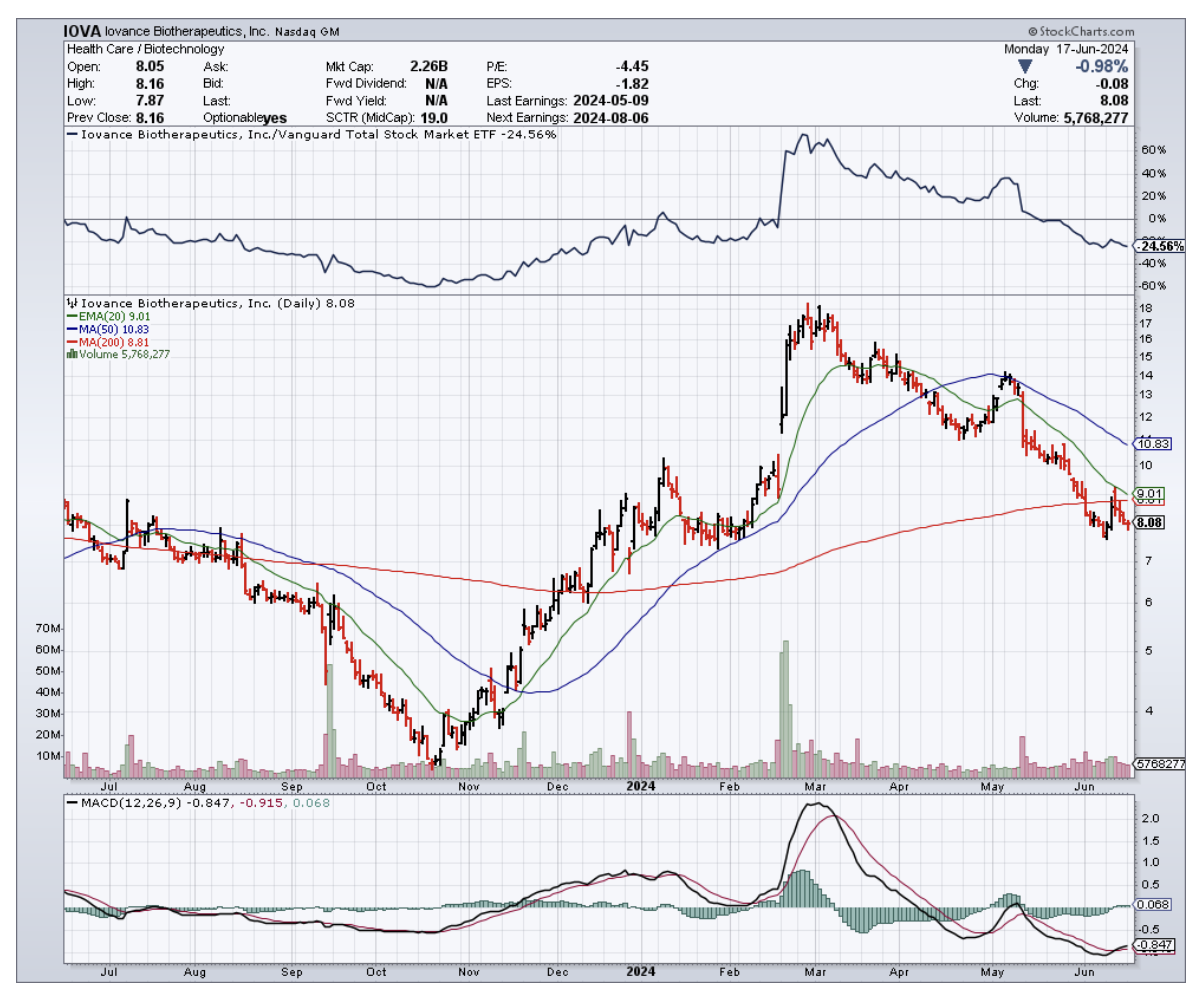
Mad Hedge Biotech and Healthcare Letter
June 18, 2024
Fiat Lux
Featured Trade:
(PHARMAGEDDON AVERTED)
(ILMN), (NVTAQ), (NTRA), (GH), (EXAS), (TMO), (QGEN), (NVS), (RHHBY), (AZN), (CRSP), (EDIT), (FATE)

For far too long, we've been playing a dangerous game of biotech roulette - throwing our hard-earned dough at stocks solely based on who's peddling the latest drugs and vaccines to the biggest crowds.
We tiptoe around those dreaded "patent cliffs", living in fear of the moment our cash cows turn into generic, discount-bin duds overnight.
As I've loudly proclaimed before, Big Pharma is fundamentally a tightrope act - milking those lucrative exclusives for all they're worth while bracing for the inevitable day those monopolies go kaput.
It's an anxiety-inducing cycle, one that's been running the show for decades.
But enough is enough. It's high time we tossed that musty old playbook straight into the trash. Why? Because the reign of Pharma's legacy model is fading faster than my hairline.
A new revolutionary force is taking over – personalized medicine.
Don't kid yourselves, this tectonic shift is the real deal. We're witnessing a paradigm upheaval in how drugs are developed and treatments are administered.
Advanced, genetically-tailored therapies are muscling their way to the frontlines, employing each patient's unique DNA blueprint to craft bespoke care strategies like never before.
Leading this charge are gene sequencing pioneers like Illumina (ILMN), equipping healthcare with bleeding-edge tech for genetic profiling and research.
Companies like Invitae (NVTAQ) and Natera (NTRA) are making genetic intel accessible and actionable for diagnosing and treating inherited nightmares like cancer and heart disease. This isn't a drill, people. It’s the new reality.
But the innovation train doesn't stop there. Guardant Health (GH) is upping the ante with its non-invasive blood tests that capture tumor genetic data, allowing physicians to map treatment plans without those pesky, invasive procedures.
And let's hear it for Exact Sciences (EXAS), championing molecular diagnostics to laser-focus cancer regimens based on each person's biological fingerprint.
Speaking of cancer, we'd be remiss not to spotlight the game-changing progress happening on the personalized medicine front.
At the latest American Society of Clinical Oncology shindig, the best oncology minds showcased their latest advancements in tailored treatments.
Get this – over the last four years, over a third of the FDA's new drug approvals were personalized meds. With the White House doubling down, those numbers are only going up.
Obviously, personalized medicine is this century's gold rush. In fact, a global biopharma race is already underway, and everyone’s practically frothing at the mouth.
After all, this half-trillion-dollar market is barreling towards the $1 trillion mark by 2031.
And in this blossoming field, outfits like Thermo Fisher (TMO) and Qiagen (QGEN) are indispensable, provisioning crucial tools and services.
Thermo covers the full genetic research and diagnostics gamut, while Qiagen specializes in sample prep and molecular testing – two linchpins for delivering personalized therapies.
But it's not just the upstart trailblazers making waves. Biotech titans like Novartis (NVS), Roche (RHHBY), and AstraZeneca (AZN) are going knees-deep into advanced, commercially-viable personalized treatments – especially in oncology, where understanding Individual genetic mutations can literally mean life or death.
Let's pour one out for the real pioneers here, too – groundbreakers like CRISPR Therapeutics (CRSP), Editas Medicine (EDIT), and Fate Therapeutics (FATE).
These mavericks are lighting up the gene editing and cell therapy arenas, hand-crafting hyper-personalized treatments that smite genetic diseases at the source.
Now, for those of you eagerly wondering where to splash your investment cash, I suggest you don't fall into the trap of banking solely on the next patented "winner" therapy.
Those old-school patent monopolies that once ruled the roost? Their significance is waning rapidly.
With the flurry of personalization tech out there, it's a Wild West – one company churns out a new treatment, another can swiftly follow suit.
Patent feuds and skyrocketing costs loom on the horizon like storm clouds. The gravy train of eternal patent profits is running out of steam.
But make no mistake, this arms race isn't cooling off anytime soon. The battleground's scope is simply shifting. It's no longer just about formulating the latest miracle drug – it's about delivering unbeatable services and customer experiences.
Because here's the cold hard truth – the biggest roadblock to getting these revolutionary therapies to patients is obtaining all the genetic data and personal insights needed to make it happen.
Healthcare providers are going to need to invest heavily in new data management systems, training, and education just to keep pace with these rapidly evolving personalized meds.
The pharma players that thrive? They're the ones going beyond prioritizing drug development to obsessing over best-in-class customer service and care delivery.
They'll cement customer loyalty, forge lasting partnerships – and in doing so, actualize personalized medicine's boundary-shattering promise. Those are the winners I'm betting big on.
So wake up and smell the coff-gene. The personalized biotech goldrush is kicking into high gear.
And those wise enough to stake an early claim? Well, let's just say they'll be dishing out more than genetics-guided therapy – they'll be minting a new generation of biotech fortunes.
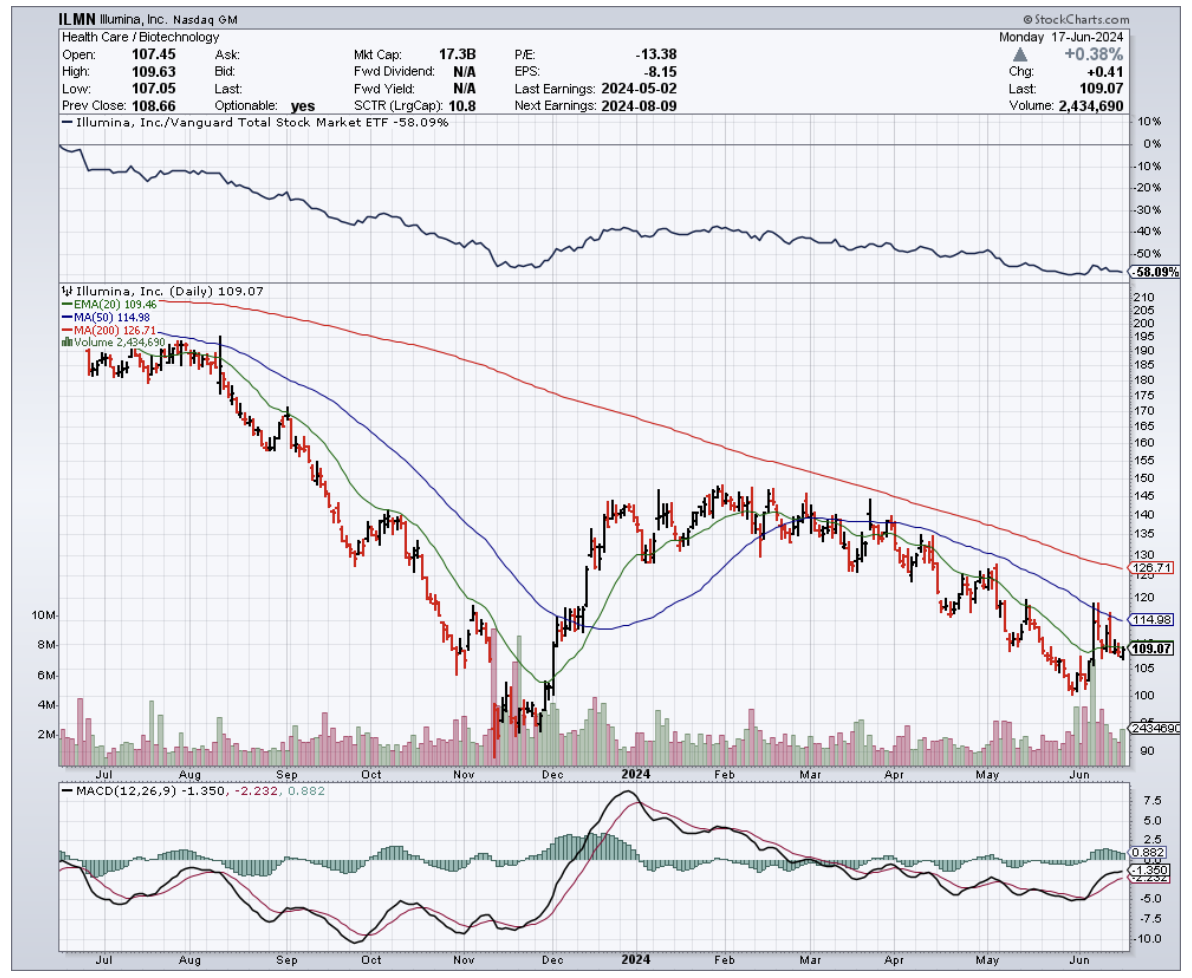
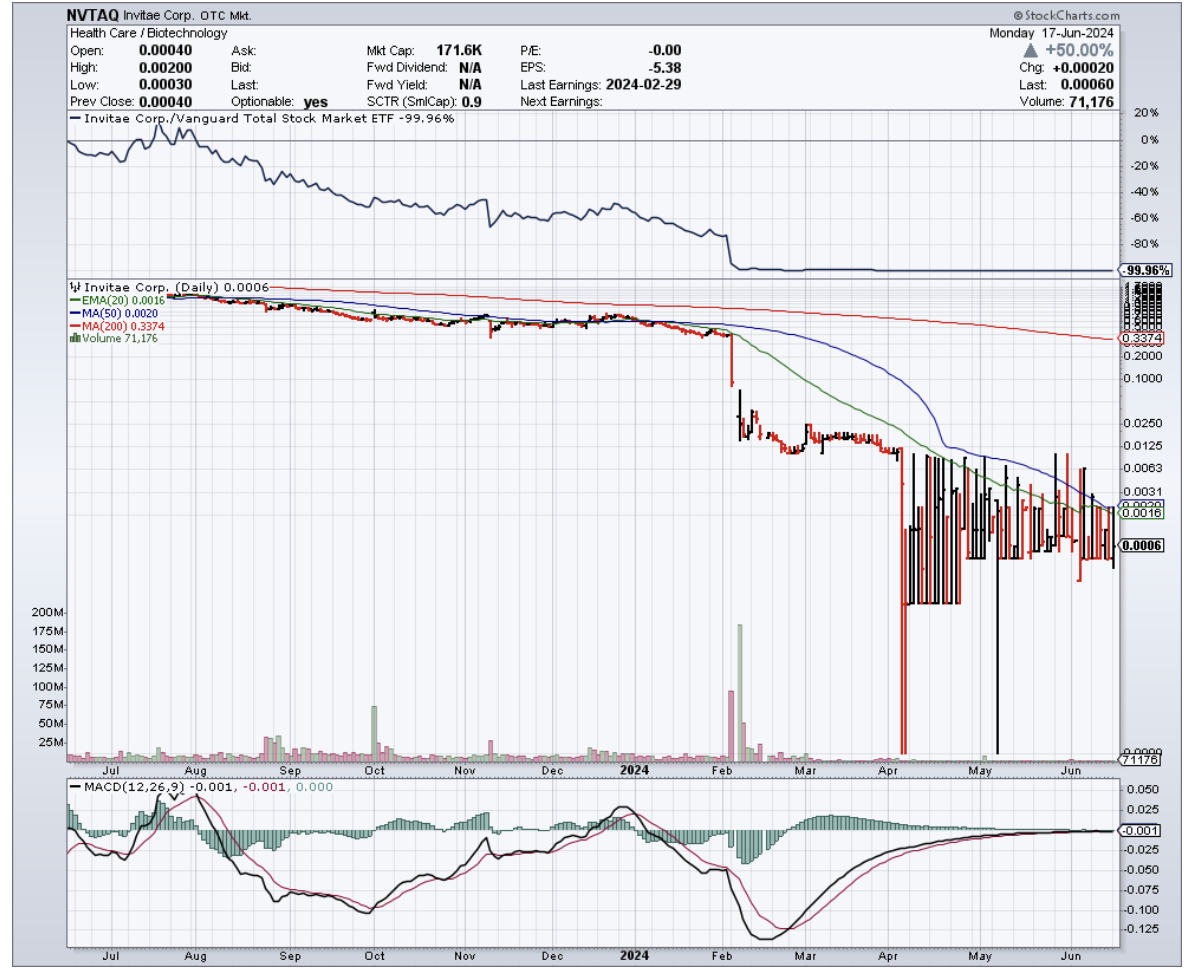
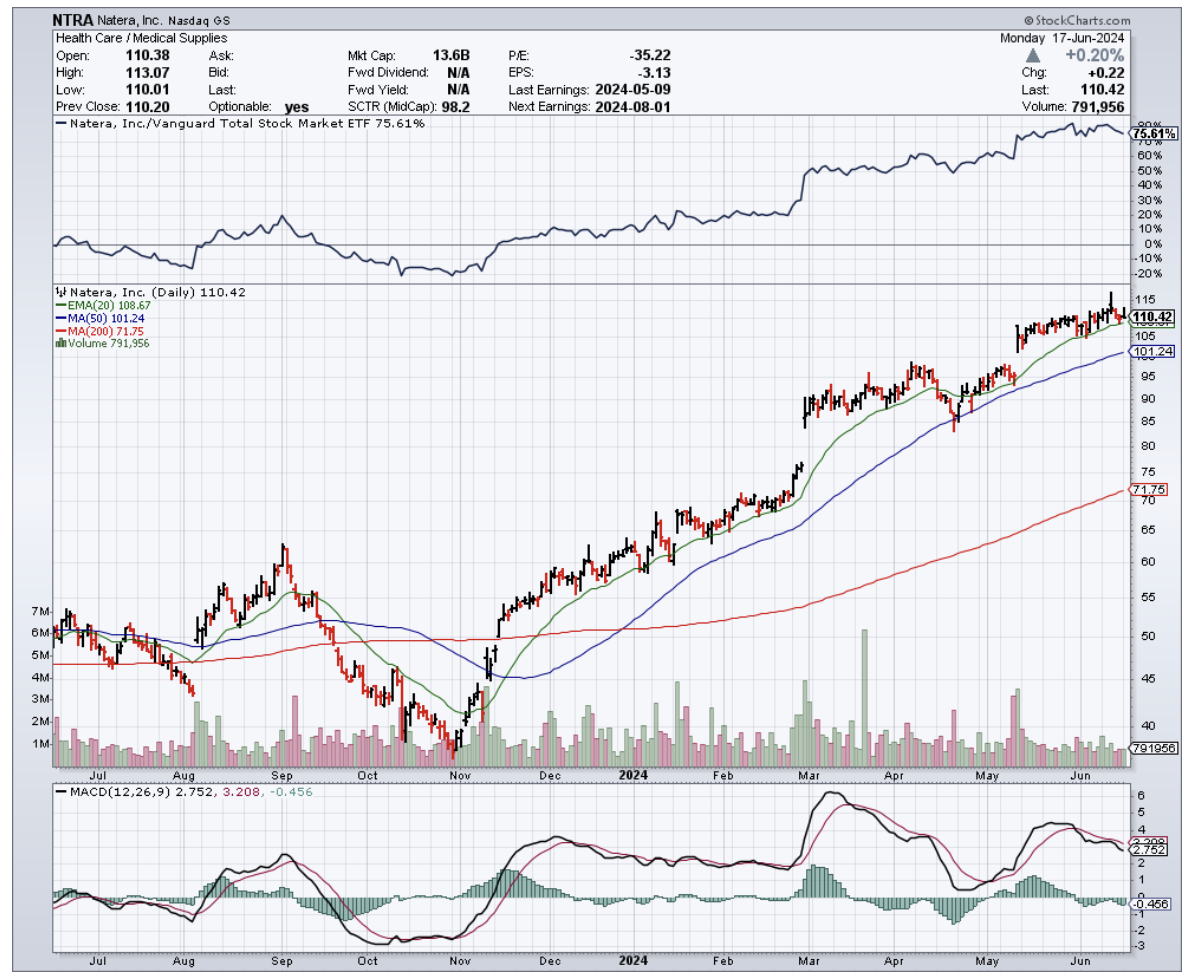
Mad Hedge Biotech and Healthcare Letter
June 13, 2024
Fiat Lux
Featured Trade:
(THE TORTOISE IN THE BIOTECH RACE THAT’S ABOUT TO CROSS THE FINISH LINE)
(AMGN), (LLY), (NVO), (IMVT), (ARGX)

You know how every golfer dreams of donning the green jacket at the Masters, every chess player longs for the title of Grandmaster, and every football player fantasizes about hoisting the Lombardi Trophy?
Well, healthcare and biotech companies have their own version of the ultimate dream: launching a product that's as successful as the latest weight loss drugs from Eli Lilly (LLY) and Novo Nordisk (NVO).
These two pharma heavyweights have been on an absolute tear, with their shares skyrocketing 611% and 471% respectively over the past five years. It's the kind of rally that'll make your head spin and your wallet sing.
And guess what? The good news just keeps on coming. Analysts have cranked up their forecast for the obesity market. They're now predicting it'll hit a jaw-dropping $130 billion by 2030, up from their previous estimate of $100 billion.
That's an extra $30 billion. I don't know about you, but I call that a pretty sweet cherry on top.
Thanks to this obesity drug frenzy, Lilly has become the world's biggest healthcare company, and Novo Nordisk is now the most valuable company in Europe. It's like watching a couple of underdogs become the kings of the castle overnight.
Now, don't get me wrong, I love a good growth story as much as the next guy, and I wouldn't bet against Lilly or Novo Nordisk. But you know what I like even more? Biotech companies that are flying under the radar. The ones that are quietly innovating and positioning themselves for big things down the road.
That's where Amgen (AMGN) comes in.
I've been singing this company's praises in almost every piece I write, and for good reason. Amgen is one of the most innovative healthcare companies out there, with a massive product portfolio, a robust pipeline, and a balance sheet that's healthier than a triathlete on a kale smoothie diet.
Let me break it down for you. Established biotech companies with strong product portfolios are like fortresses in the business world.
They've got wide moats that are harder to cross than the Strait of Gibraltar. Why? Because bringing a new drug to market costs an arm and a leg.
We're talking anywhere from $314 million to $2.8 billion, depending on who you ask. That's not exactly chump change.
But Amgen? They've got it all figured out. Their portfolio spans a variety of therapeutic areas, including general medicine, oncology, inflammation, and rare diseases.
And in the first quarter of this year, these products helped Amgen rake in a whopping $7.4 billion in revenue, a 22% increase from the same period last year.
Key drugs like Repatha, Evenity, Blincyto, and Tezpire are leading the charge, with growth rates that'll make your head spin.
Repatha alone saw record sales of $517 million, thanks to a 44% increase in volume. And get this: expanded coverage and the removal of prior authorization requirements made the drug more accessible to patients.
It's like Amgen waved a magic wand and made all the red tape disappear.
Still, Amgen isn't just content with dominating the US market. They're taking their show on the road and expanding their international footprint.
Evenity, for example, has become the segment leader in Japan, capturing a staggering 46% of the bone builder market. And Uplinza, Amgen's fastest-growing biologic for a rare neurological disorder called neuromyelitis optica spectrum disorder (NMOSD), has been launched in multiple markets, including Canada.
Speaking of Uplinza, this little powerhouse came to Amgen via their $27.8 billion acquisition of Horizon last year. And let me tell you, it's paying off in spades.
In the first quarter of 2023, sales of Uplinza shot up by roughly 60%. And its smaller sibling, Tavneos, which targets a rare blood vessel disorder, saw a mind-boggling 122% growth.
The good news doesn't stop there. Amgen just released some hot-off-the-press Phase 3 data for Uplinza in another autoimmune condition, bringing it one step closer to yet another FDA approval.
This could put some serious pressure on competitors like Immunovant (IMVT) and argenx (ARGX), who have hit a few speed bumps lately.
Now, I know what you're thinking. "But John, what about the obesity market? Isn't that where the real action is?" Well, let me tell you, Amgen's got its fingers in that pie too.
They've got a unique obesity drug candidate called MariTide, which I talked about in detail last month, and the early clinical trial data suggests that it could blow Eli Lilly and Novo Nordisk's drugs out of the water.
But Amgen isn't just about cutting-edge drugs and international expansion. They're also rewarding their shareholders with cold, hard cash.
Last December, they hiked their dividend by 5.6%, and they're now paying out $2.25 per share every quarter.
That translates to a juicy 3% yield, and it's backed by a payout ratio that's lower than a limbo stick at a beach party.
Plus, Amgen's been raising its dividend like clockwork, with a five-year compound annual growth rate of 9.6% and 12 consecutive annual hikes. That's the kind of consistency that'll make any investor smile.
Overall, it’s clear that Amgen is a standout in the biotech world, plain and simple.
Besides, this company isn’t some Johnny-come-lately to the biotech game. They've been in this fight since the beginning, and their very name is proof of their founding principles. In fact, “Amgen” is a fancy-pants word for "applied molecular genetics."
That's right, when they picked that name back in 1980, they were already knee-deep in the groundbreaking science of genetic engineering, cooking up new therapies that would change the face of medicine as we know it.
So here’s my advice. When the chips are down and the stakes are high, you can never go wrong to bet on the OG of applied molecular genetics. Buy the dip on Amgen.
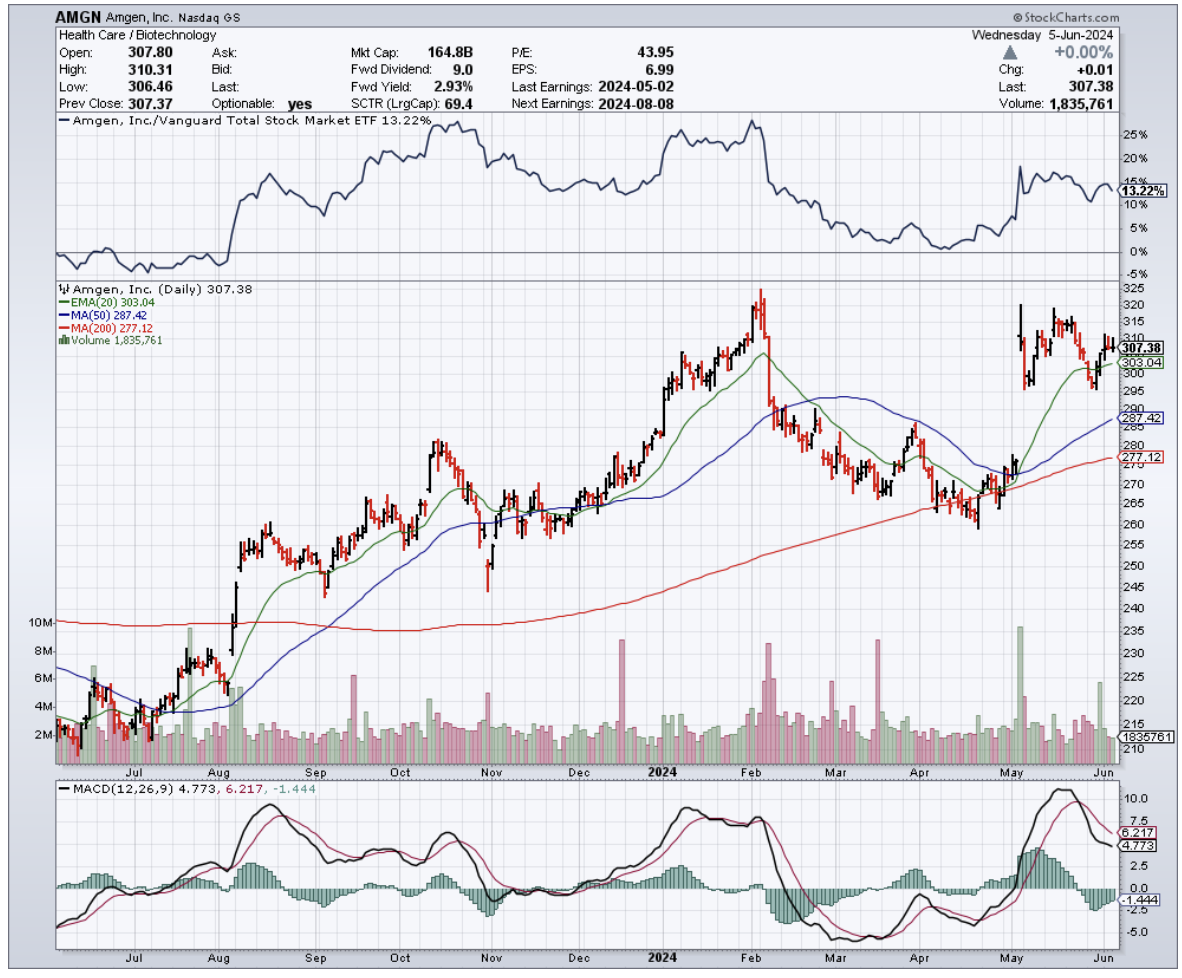
Legal Disclaimer
There is a very high degree of risk involved in trading. Past results are not indicative of future returns. MadHedgeFundTrader.com and all individuals affiliated with this site assume no responsibilities for your trading and investment results. The indicators, strategies, columns, articles and all other features are for educational purposes only and should not be construed as investment advice. Information for futures trading observations are obtained from sources believed to be reliable, but we do not warrant its completeness or accuracy, or warrant any results from the use of the information. Your use of the trading observations is entirely at your own risk and it is your sole responsibility to evaluate the accuracy, completeness and usefulness of the information. You must assess the risk of any trade with your broker and make your own independent decisions regarding any securities mentioned herein. Affiliates of MadHedgeFundTrader.com may have a position or effect transactions in the securities described herein (or options thereon) and/or otherwise employ trading strategies that may be consistent or inconsistent with the provided strategies.
This site uses cookies. By continuing to browse the site, you are agreeing to our use of cookies.
OKLearn moreWe may request cookies to be set on your device. We use cookies to let us know when you visit our websites, how you interact with us, to enrich your user experience, and to customize your relationship with our website.
Click on the different category headings to find out more. You can also change some of your preferences. Note that blocking some types of cookies may impact your experience on our websites and the services we are able to offer.
These cookies are strictly necessary to provide you with services available through our website and to use some of its features.
Because these cookies are strictly necessary to deliver the website, refuseing them will have impact how our site functions. You always can block or delete cookies by changing your browser settings and force blocking all cookies on this website. But this will always prompt you to accept/refuse cookies when revisiting our site.
We fully respect if you want to refuse cookies but to avoid asking you again and again kindly allow us to store a cookie for that. You are free to opt out any time or opt in for other cookies to get a better experience. If you refuse cookies we will remove all set cookies in our domain.
We provide you with a list of stored cookies on your computer in our domain so you can check what we stored. Due to security reasons we are not able to show or modify cookies from other domains. You can check these in your browser security settings.
These cookies collect information that is used either in aggregate form to help us understand how our website is being used or how effective our marketing campaigns are, or to help us customize our website and application for you in order to enhance your experience.
If you do not want that we track your visist to our site you can disable tracking in your browser here:
We also use different external services like Google Webfonts, Google Maps, and external Video providers. Since these providers may collect personal data like your IP address we allow you to block them here. Please be aware that this might heavily reduce the functionality and appearance of our site. Changes will take effect once you reload the page.
Google Webfont Settings:
Google Map Settings:
Vimeo and Youtube video embeds:
